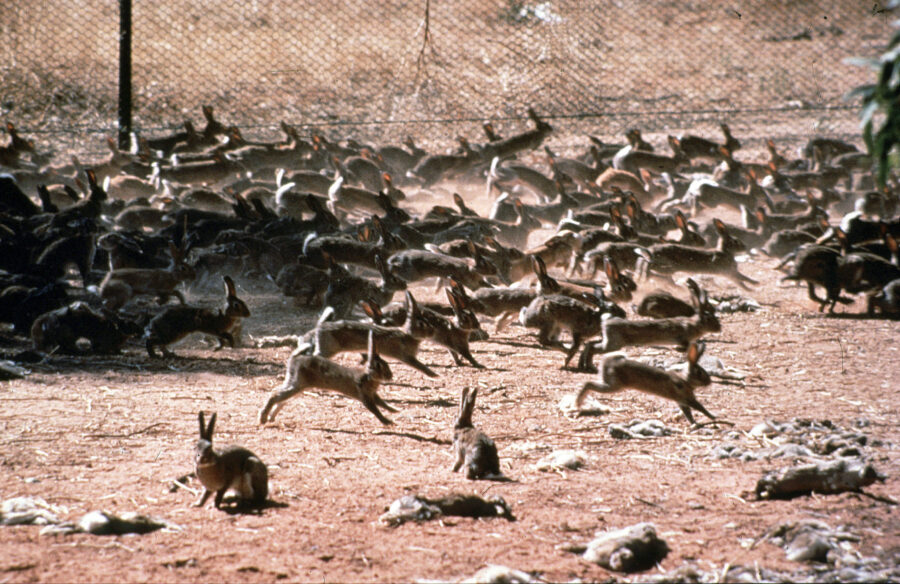Defining Moments in Australian History: A scourge begins

On Christmas Day 1859 wealthy settler Thomas Austin released 13 wild European rabbits onto his estate, Winchelsea, at Barwon Park in Victoria. They had been specially collected and sent to him by a relative in England for the purpose of hunting for sport.
This was not the first diffusion of rabbits on the continent. Andrew Miller, commissary for the First Fleet, listed five rabbits on the initial transport. They were probably silver greys – then a popular breed for hutch rearing in England – but they were never released into the wild.
The impact of rabbits at Winchelsea was quickly apparent after their release. By 1866 hunters had bagged 14,000 on the Barwon Park estate. Abundant food sources, good ground cover and a lack of predators supported the spread of rabbits across the landscape. By 1880 they’d crossed the Murray River into New South Wales and had reached Queensland by 1886. In 1894 they’d traversed the Nullarbor and populated Western Australia.
To put this dissemination into context, it took 700 years for rabbits, which are native to the Iberian Peninsula, to spread across Great Britain. The species’ colonisation of two-thirds of Australia, an area 25 times the size of Britain, took just 50 years – the fastest rate of spread of a colonising mammal anywhere in the world.
Different methods of rabbit control were tried throughout the 19th and 20th centuries. These included trapping, rabbit-warren ripping, fumigation, bounty systems and fencing, the most visible control method. Fences became an integral component of what late 19th-century settlers began to see as a war against rabbits. The first extensive fences were built in central NSW and the initial success of private fencing encouraged state governments to construct even longer ones. Between 1885 and 1890, demand for wire netting increased from 1600km to 9600km per year. It’s estimated that by the height of the fence construction boom there were 320,000km of rabbit-proof fences across Australia. The most iconic is the State Barrier Fence – made up of three fences built between 1901 and 1907 – that extended 3256km north to south across WA. This fence, like almost all the very long government-sponsored fences, was unsuccessful for several reasons. It was completed after the rabbits had already crossed into the state, and the constant deterioration of the fence meant there was usually somewhere rabbits could cross.
By the late 1940s the rabbit population had risen rapidly to 600 million, due to a number of high rainfall years with subsequent good harvests, as well as World War II, which had led to a reduced labour force for trapping and fence maintenance. Although rabbits were a scourge, they were also free food. During the Great Depression of the 1930s, many people shot or trapped them for meat.
Initial tests in 1943 on the rabbit virus myxomatosis had been inconclusive. But in the post-war years, when farmers were being eaten off their land by rabbits, public pressure increased to find a solution and in 1950 trials restarted on myxomatosis. Initially these trials, which were conducted in the Murray Valley west of Albury by the newly formed CSIRO, seemed a failure. But rains in December 1950 produced more mosquitoes, the vector that carries the virus, and the disease spread with incredible speed.
Scientists were shocked. The renowned microbiologist Frank Fenner commented that “for scale and speed [the myxomatosis epidemic] must be without parallel in the history of infections”. Ironically, the animal that thrived better than any other introduced mammal was now dying at record speed. Rabbits, however, began developing a resistance to myxomatosis, just as they later did to the calicivirus, officially released in 1996. Rabbit numbers are now on the rise again in Australia.
The effect of rabbits on the environment has been catastrophic. Rabbits can survive on almost any type of plant matter. The long-term result of rapidly reproducing rabbits is overgrazing by an extremely large population, which can lead to a collapse of native plant species and the native animals that eat them. Excessive grazing also leads to soil erosion, which affects pasture yields and water quality. It’s estimated that rabbits cost the Australian economy more than $200 million per year.
Australia’s native species adapted to life on an isolated continent over millions of years. But since European colonisation they’ve had to compete with a range of new animals for habitat, food and shelter. These introduced species have had a major impact on Australia’s soil and waterways and native plant and animal diversity. Rabbits are one of the most visible and destructive of these introduced species.
‘A scourge begins’ forms part of the National Museum of Australia’s Defining Moments in Australian History project.

